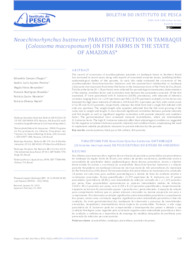Neoechinorhynchus buttnerae parasitic infection in tambaqui (Colossoma macropomum) on fish farms in the state of Amazonas.
Neoechinorhynchus buttnerae parasitic infection in tambaqui (Colossoma macropomum) on fish farms in the state of Amazonas.
Autoria: CHAGAS, E. C.; PEREIRA, S. L. A.; BENAVIDES, M. V.; BRANDÃO, F. R.; MONTEIRO, P. C.; MACIEL, P. O.
Resumo: The record of occurrence of acanthocephalan parasites on tambaqui farms in Northern Brazil has increased in recent years along with reports of associated economic losses, justifying further epidemiological studies of this parasite. As such, this study evaluated the occurrence of the acanthocephalan Neoechinorhynchus buttnerae and the parasite-host relationship in tambaqui (Colossoma macropomum) from three fish farms in the Amazonian town of Rio Preto da Eva, Brazil. Fish from the farms (N = 18 per farm) were collected for parasitological examination, determination of the relative condition factor and correlation tests between the parameters assessed. Of the fish examined, 37 were parasitized with N. buttnerae (68.5% prevalence), with intensity of infection variation ranging from 1 to 1,219 specimens per fish (12,279 specimens counted). In two farms was detected the high mean intensity of infection, 230.8 and 451.3 parasites per fish, with a total count of 4,155 and 8,123 parasites, respectively, whereas the third farm had a single fish infected with only one specimen. The weight-length ratio equation indicated that the fish were growing at the same rate in weight and length. It was observed significant correlation between parasite intensity and fish length, as well as significant negative correlation with parasite intensity and condition factor. The gastrointestinal tract contained ostracod invertebrates, which are intermediate N. buttnerae hosts. The high N. buttnerae intensity affect their physiological condition as suggested by the negative correlation between parasitic intensity and condition factor, emphasizing the need to implement suitable prophylactic measures to prevent infection by the parasite.
Ano de publicação: 2019
Tipo de publicação: Artigo de periódico
Unidade: Embrapa Amazônia Ocidental
Palavras-chave: Acantocéfalos, Colossoma Macropomum, Infecção, Parasitos de peixes, Pesca, Piscicultura, Tambaqui
Observações
1 - Por padrão são exibidas publicações dos últimos 20 anos. Para encontrar publicações mais antigas, configure o filtro ano de publicação, colocando o ano a partir do qual você deseja encontrar publicações. O filtro está na coluna da esquerda na busca acima.
2 - Para ler algumas publicações da Embrapa (apenas as que estão em formato ePub), é necessário ter, no celular ou computador, um desses softwares gratuitos. Sistemas Android: Google Play Livros; IOS: iBooks; Windows e Linux: software Calibre.
Acesse outras publicações
Acesse a Base de Dados da Pesquisa Agropecuária (BDPA) para consultar o acervo completo das bibliotecas da Embrapa.

